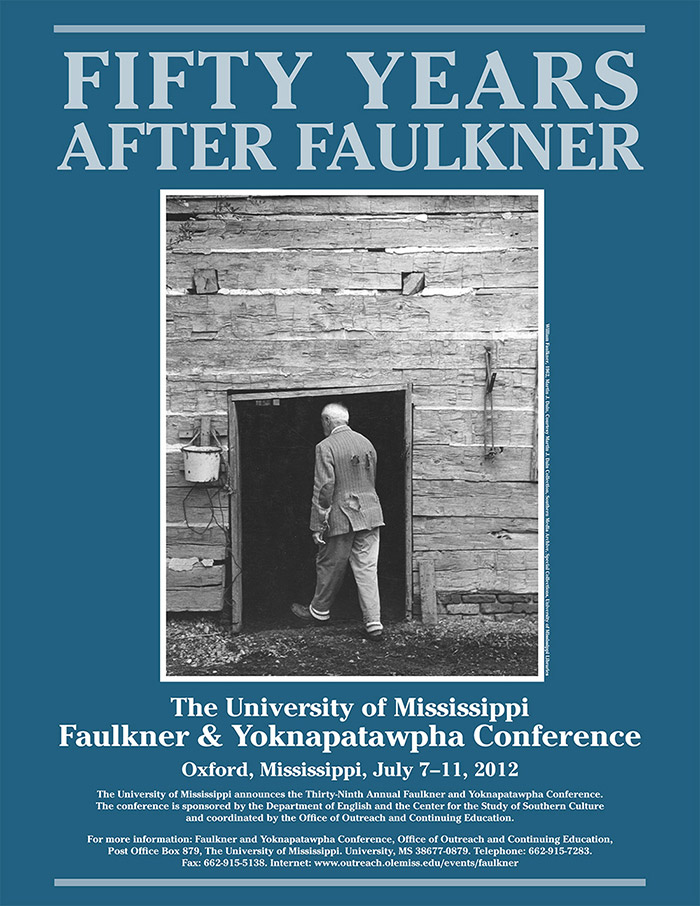
Panel. Faulkner's Afterlives, Literary Heirs
Location
Nutt Auditorium
Start Date
11-7-2012 9:30 AM
Description
- Yoknapatawpha County in East Germany: How Dixie Came to Symbolize the Defeat of Socialism / Beatrix Brockman, Austin Peay State University
It is widely known that Ingo Schulze’s concept of authorship includes searching the works of other writers for a voice that will suit the subject matter of his current project. Thus scholarship has clearly established that his novel Simple Storys [sic], hailed as the first novel about a united Germany, has largely been inspired by Robert Altman’s movie Short Cuts, which in turn is based on short stories and one poem by Raymond Carver. This analysis of Simple Storys shows, however, that Schulze also writes about the disorientation and alienation experienced by East Germans shortly after the reunification in a style that exhibits traits of the prose of one of America’s most famous and distinct Southern authors: William Faulkner. My reading of Schulze’s novel reveals many traits particular to Southern fiction as well as very clear allusions to Faulkner’s works As I Lay Dying, Sanctuary, and The Sound and the Fury. - Intertextual Afterlives: Faulkner’s Addie and Plath’s Daddy / Jolene Hubbs, University of Alabama
My paper argues that Sylvia Plath’s most famous poetic persona—the powerful, death-obsessed speaker of “Daddy”—has significant narrative and thematic affinities with Addie Bundren, the commanding, death-consumed narrator of As I Lay Dying. Using archival evidence and reading Addie Bundren as a proto-confessionalist, I dilate upon one of Faulkner’s less explored afterlives: his influence on Plath’s iconic poem—a work that emerged halfway between the July 1962 death of Faulkner and the February 1963 death of Plath. This approach bridges the long-cited divide between modernism and confessional poetry by establishing the noteworthy connections between the modes’ signal practitioners, allowing us to rethink the scope of Faulkner’s impact on mid-twentieth-century literary history. - A Refusal to Look Away: Morrison on Faulkner, Then and Now / Sarah Perkins, Stanford University
My paper traces the trajectory of Morrison’s literary criticism of Faulkner from her 1955 Masters thesis to her influential Playing in the Dark (1992). Rarely are these two pieces considered together. Indeed, Morrison presents her arguments through dramatically different critical voices and modes. Morrison’s early thesis, composed long before she began writing her own fiction, involves a careful analysis of alienation in Faulkner’s novels. Read in hindsight, her study is remarkable for its utter lack of attention to race and nation – subjects that are central to Playing in the Dark. As I show, Morrison’s literary criticism highlights the transformations in academic approaches to Faulkner over the past fifty years, as well as our “refusal to look away.”
Relational Format
Conference proceeding
Recommended Citation
Brockman, Beatrix; Hubbs, Jolene; and Perkins, Sarah, "Panel. Faulkner's Afterlives, Literary Heirs" (2012). Faulkner and Yoknapatawpha Conference. 57.
https://egrove.olemiss.edu/fy/2012/schedule/57
COinS
Jul 11th, 9:30 AM
Panel. Faulkner's Afterlives, Literary Heirs
Nutt Auditorium
- Yoknapatawpha County in East Germany: How Dixie Came to Symbolize the Defeat of Socialism / Beatrix Brockman, Austin Peay State University
It is widely known that Ingo Schulze’s concept of authorship includes searching the works of other writers for a voice that will suit the subject matter of his current project. Thus scholarship has clearly established that his novel Simple Storys [sic], hailed as the first novel about a united Germany, has largely been inspired by Robert Altman’s movie Short Cuts, which in turn is based on short stories and one poem by Raymond Carver. This analysis of Simple Storys shows, however, that Schulze also writes about the disorientation and alienation experienced by East Germans shortly after the reunification in a style that exhibits traits of the prose of one of America’s most famous and distinct Southern authors: William Faulkner. My reading of Schulze’s novel reveals many traits particular to Southern fiction as well as very clear allusions to Faulkner’s works As I Lay Dying, Sanctuary, and The Sound and the Fury. - Intertextual Afterlives: Faulkner’s Addie and Plath’s Daddy / Jolene Hubbs, University of Alabama
My paper argues that Sylvia Plath’s most famous poetic persona—the powerful, death-obsessed speaker of “Daddy”—has significant narrative and thematic affinities with Addie Bundren, the commanding, death-consumed narrator of As I Lay Dying. Using archival evidence and reading Addie Bundren as a proto-confessionalist, I dilate upon one of Faulkner’s less explored afterlives: his influence on Plath’s iconic poem—a work that emerged halfway between the July 1962 death of Faulkner and the February 1963 death of Plath. This approach bridges the long-cited divide between modernism and confessional poetry by establishing the noteworthy connections between the modes’ signal practitioners, allowing us to rethink the scope of Faulkner’s impact on mid-twentieth-century literary history. - A Refusal to Look Away: Morrison on Faulkner, Then and Now / Sarah Perkins, Stanford University
My paper traces the trajectory of Morrison’s literary criticism of Faulkner from her 1955 Masters thesis to her influential Playing in the Dark (1992). Rarely are these two pieces considered together. Indeed, Morrison presents her arguments through dramatically different critical voices and modes. Morrison’s early thesis, composed long before she began writing her own fiction, involves a careful analysis of alienation in Faulkner’s novels. Read in hindsight, her study is remarkable for its utter lack of attention to race and nation – subjects that are central to Playing in the Dark. As I show, Morrison’s literary criticism highlights the transformations in academic approaches to Faulkner over the past fifty years, as well as our “refusal to look away.”

